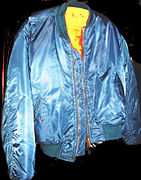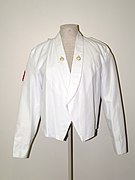
Black tie is a semi-formal Western dress code for evening events, originating in British and North American conventions for attire in the 19th century. In British English, the dress code is often referred to synecdochically by its principal element for men, the dinner suit or dinner jacket. In American English, the equivalent term tuxedo is common. The dinner suit is a black, midnight blue or white two- or three-piece suit, distinguished by satin or grosgrain jacket lapels and similar stripes along the outseam of the trousers. It is worn with a white dress shirt with standing or turndown collar and link cuffs, a black bow tie, typically an evening waistcoat or a cummerbund, and black patent leather dress shoes or court pumps. Accessories may include a semi-formal homburg, bowler, or boater hat. For women, an evening gown or other fashionable evening attire may be worn.

A sweater or pullover, also called a jersey or jumper, is a piece of clothing, typically with long sleeves, made of knitted or crocheted material that covers the upper part of the body. When sleeveless, the garment is often called a slipover, tank top, or sweater vest.

A shirt is a cloth garment for the upper body.

A waistcoat or vest is a sleeveless upper-body garment. It is usually worn over a dress shirt and necktie and below a coat as a part of most men's formal wear. It is also sported as the third piece in the traditional three-piece male suit. Any given waistcoat can be simple or ornate, or for leisure or luxury. Historically, the waistcoat can be worn either in the place of, or underneath, a larger coat, dependent upon the weather, wearer, and setting.

Mess dress uniform is the most formal type of evening-wear uniform used by military personnel, police personnel, and other uniformed services members. It frequently consists of a mess jacket, trousers, white dress shirt and a black bow tie, along with orders and medals insignia. Design may depend on regiment or service branch, e.g. army, navy, air force, marines, etc. In modern Western dress codes, mess dress uniform is the supplementary alternative equivalent to the civilian black tie for evening wear. Mess dress uniforms are typically less formal than full dress uniform, but more formal than service dress uniform.

A frock coat is a formal men's coat characterised by a knee-length skirt cut all around the base just above the knee, popular during the Victorian and Edwardian periods (1830s–1910s). It is a fitted, long-sleeved coat with a centre vent at the back and some features unusual in post-Victorian dress. These include the reverse collar and lapels, where the outer edge of the lapel is often cut from a separate piece of cloth from the main body and also a high degree of waist suppression around the waistcoat, where the coat's diameter round the waist is less than round the chest. This is achieved by a high horizontal waist seam with side bodies, which are extra panels of fabric above the waist used to pull in the naturally cylindrical drape. As was usual with all coats in the 19th century, shoulder padding was rare or minimal.
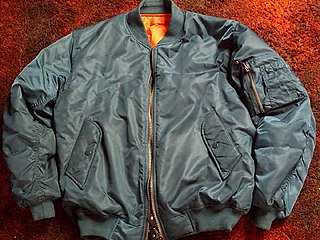
A flight jacket is a casual jacket that was originally created for pilots and eventually became part of popular culture and apparel. It has evolved into various styles and silhouettes, including the letterman jacket and the fashionable bomber jacket that is known today.

A flight suit is a full-body garment, worn while flying aircraft such as military airplanes, gliders and helicopters. These suits are generally made to keep the wearer warm, as well as being practical, and durable. Its appearance is usually similar to a jumpsuit. A military flight suit may also show rank insignia. It is sometimes used by Special Forces as a combat uniform in close quarters battle or visit, board, search, and seizure situations, for its practicality.
Clothing terminology comprises the names of individual garments and classes of garments, as well as the specialized vocabularies of the trades that have designed, manufactured, marketed and sold clothing over hundreds of years.

A windbreaker, or a windcheater, is a thin fabric jacket designed to resist wind chill and light rain, making it a lighter version of the jacket. It is usually of lightweight construction and characteristically made of a synthetic material. A windbreaker often uses elastic waistbands, and/or armbands, and a zipper to allow adjustments for the current weather conditions.
Semi-formal wear or half dress is a grouping of dress codes indicating the sort of clothes worn to events with a level of formality between informal wear and formal wear. In the modern era, the typical interpretation for men is black tie for evening wear and black lounge suit for day wear, corresponded by either a pant suit or an evening gown for women.

Fashion in the 1990s was defined by a return to minimalist fashion, in contrast to the more elaborate and flashy trends of the 1980s. One notable shift was the mainstream adoption of tattoos, body piercings aside from ear piercing and, to a much lesser extent, other forms of body modification such as branding.

A sport coat, also called a sport jacket, is a men's smart casual lounge jacket designed to be worn on its own without matching trousers, traditionally for sporting purposes. Styles, fabrics, colours and patterns are more varied than in most suits; sturdier and thicker fabrics are commonly used, such as corduroy, suede, denim, leather, and tweed.
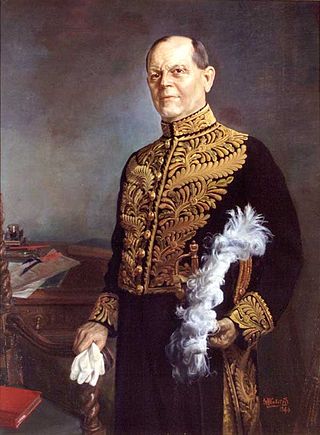
Court uniform and dress were required to be worn by those in attendance at the royal court in the 19th and early 20th centuries.
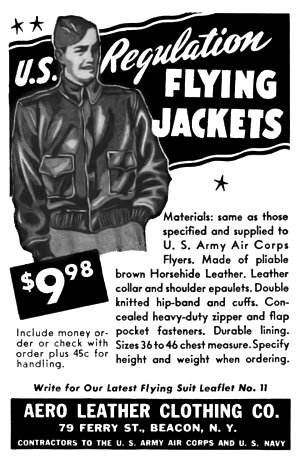
The Type A-2 leather flight jacket is an American military flight jacket originally invented and developed for and closely associated with World War II U.S. Army Air Forces pilots, navigators and bombardiers, who often decorated their jackets with squadron patches and elaborate artwork painted on the back. Sometimes casually referred to as a bomber jacket, its original designation was "Jacket, Pilot's (summer)", and its wartime usage was limited neither to pilots nor to bomber crews.

Fashion in the 1970s was about individuality. In the early 1970s, Vogue proclaimed "There are no rules in the fashion game now" due to overproduction flooding the market with cheap synthetic clothing. Common items included mini skirts, bell-bottoms popularized by hippies, vintage clothing from the 1950s and earlier, and the androgynous glam rock and disco styles that introduced platform shoes, bright colors, glitter, and satin.

The MA-1 bomber jacket is an American military jacket which was developed in the 1950s. The MA-1 and its predecessor, the B-15 flight jacket, were originally developed and needed at that time because the characteristics of the new jet aircraft created new requirements for pilot performance, safety, and comfort.
This is a list of existing articles related to fashion and clothing. For individual designers, see List of fashion designers

A blouson or blouse jacket is a jacket that is drawn tight at the waist, causing it to blouse out and hang over the waistband. Originating in military uniforms of the mid-20th century, versions continue to be used as part of military, paramilitary and law enforcement uniforms in many places. As a piece of civilian clothing, it is considered to be both sportswear and casual clothing.

Fashion and clothing in the Philippines refers to the way the people of the Philippine society generally dress up at home, at work, travelling and during special occasions.


